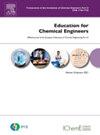A simulation tool for pinch analysis and heat exchanger/heat pump integration in industrial processes: Development and application in challenge-based learning
IF 2.3
2区 教育学
Q1 EDUCATION, SCIENTIFIC DISCIPLINES
引用次数: 0
Abstract
A novel simulation tool for pinch analysis and heat exchanger/heat pump integration has been developed and tested on a variety of process problems. The tool enables users to efficiently solve problems of varying complexity that would be cumbersome to address manually, thus, aligning with industrial practice where engineers rely on commercial software to streamline analysis and design processes. Demonstrations using the tool show that it can accurately produce composite and grand composite curves and compute heating/cooling utility targets, heat recovery targets and pinch points, for any given process data. It can also determine heat exchanger networks that realise these targets. A key distinguishing feature of the tool is its integration of Heat Pumps, which is particularly relevant given the growing trend toward the electrification of heat in industrial systems. Through several case studies, students applied the tool to optimise process energy systems, demonstrating its potential to enhance learning outcomes while providing valuable insights into energy efficiency and decarbonisation strategies. Applied in an industrial decarbonisation challenge in collaboration with a food manufacturer, the tool generates heat exchanger and heat pump integration solutions resulting in significant energy savings—up to 48 % in heating utilities and 100 % in cooling utilities. Overall, the simulation tool effectively bridges the gap between academic learning and industry practice, offering a unique and impactful approach to sustainability education.
工业过程中夹紧分析和热交换器/热泵集成的仿真工具:在基于挑战的学习中的开发和应用
一种用于夹紧分析和热交换器/热泵集成的新型仿真工具已经开发出来,并在各种工艺问题上进行了测试。该工具使用户能够有效地解决各种复杂的问题,这些问题手工处理起来很麻烦,因此,与工程师依赖商业软件来简化分析和设计过程的工业实践保持一致。使用该工具的演示表明,它可以准确地生成复合曲线和大复合曲线,并计算任何给定过程数据的加热/冷却效用目标、热回收目标和夹点。它还可以确定实现这些目标的热交换器网络。该工具的一个关键特点是它集成了热泵,考虑到工业系统中热量电气化的趋势日益增长,这一点尤为重要。通过几个案例研究,学生们将该工具应用于优化过程能源系统,展示了其提高学习成果的潜力,同时为能源效率和脱碳策略提供了有价值的见解。在与一家食品制造商合作的工业脱碳挑战中,该工具产生了热交换器和热泵集成解决方案,从而在供暖设施中节省了48% %的能源,在制冷设施中节省了100% %的能源。总体而言,模拟工具有效地弥合了学术学习和行业实践之间的差距,为可持续发展教育提供了独特而有影响力的方法。
本文章由计算机程序翻译,如有差异,请以英文原文为准。
求助全文
约1分钟内获得全文
求助全文
来源期刊

Education for Chemical Engineers
Multiple-
CiteScore
8.80
自引率
17.90%
发文量
30
审稿时长
31 days
期刊介绍:
Education for Chemical Engineers was launched in 2006 with a remit to publisheducation research papers, resource reviews and teaching and learning notes. ECE is targeted at chemical engineering academics and educators, discussing the ongoingchanges and development in chemical engineering education. This international title publishes papers from around the world, creating a global network of chemical engineering academics. Papers demonstrating how educational research results can be applied to chemical engineering education are particularly welcome, as are the accounts of research work that brings new perspectives to established principles, highlighting unsolved problems or indicating direction for future research relevant to chemical engineering education. Core topic areas: -Assessment- Accreditation- Curriculum development and transformation- Design- Diversity- Distance education-- E-learning Entrepreneurship programs- Industry-academic linkages- Benchmarking- Lifelong learning- Multidisciplinary programs- Outreach from kindergarten to high school programs- Student recruitment and retention and transition programs- New technology- Problem-based learning- Social responsibility and professionalism- Teamwork- Web-based learning
 求助内容:
求助内容: 应助结果提醒方式:
应助结果提醒方式:


